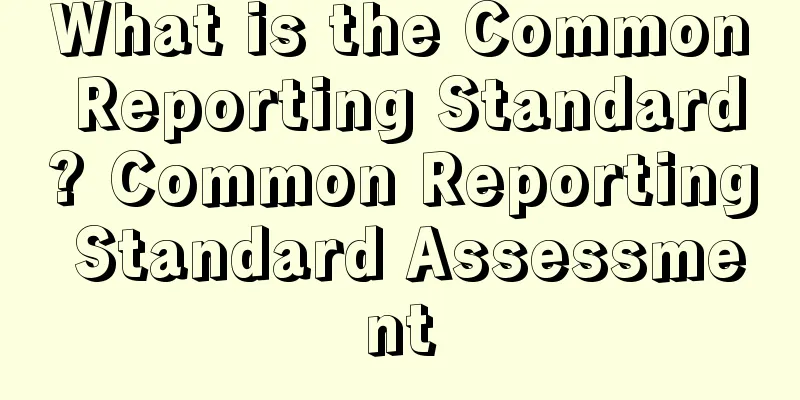What is the Common Reporting Standard? Common Reporting Standard Assessment

|
Common Reporting Standard (CRS) is also known as "Uniform Reporting Standard". The proposer of CRS is the Organization for Economic Cooperation and Development, or OECD. The concept comes from the U.S. Foreign Account Tax Compliance Act (FATCA). CRS aims to promote the automatic exchange of tax information between countries. It is being implemented in various countries step by step and is expected to fully cover all member countries in 2018. Although it is not a legally binding template, the organization that initiated CRS, OECD, advocates that member countries should sign an agreement on the exchange of citizen information as required. Term Type Tax About CRS CRS is the abbreviation of Common Reporting Standard, which is translated into Chinese as “Uniform Reporting Standard”. It was proposed by the Organization for Economic Cooperation and Development, also known as OECD. Two years ago, the OECD proposed guidelines in Australia to guide participating jurisdictions to regularly exchange information on financial accounts of tax residents, aiming to improve tax transparency and combat tax evasion through strengthening global tax cooperation. To give a simple example, if a Chinese person goes to the UK one day and deposits a considerable amount of money, then the British bank will be obliged to disclose the amount of the Chinese person's deposit to the State Administration of Taxation of China. This is information exchange. The first country on the planet that wanted to exchange information was actually the United States. The United States began to promote the principle of information exchange in 2010, which was its Foreign Account Tax Compliance Act (FATCA), which the Taiwanese translated as the Fat Cat Act. The United States pushed it very hard, but it was very effective. For example, the United States first found Switzerland, and Switzerland disclosed all American deposit information to the United States, helping the United States collect a large amount of taxes. So the United States required all countries in the market to sign information exchange rules with it. The United States did a good job, and OECD member countries also began to follow suit. The Common Reporting Standard aims to promote the automatic exchange of tax information between countries and is being implemented in various countries step by step, and is expected to fully cover all member countries in 2018. Although it is not a legally binding model, the OECD, the organization that initiated the CRS, advocates that all member countries should sign an agreement on the exchange of citizen information in accordance with the requirements. What information will be exchanged
CRS and China China committed to implement AEOI (Standard for Automatic Exchange of Financial Account Information in Tax Matters) as early as September 2014. In December 2015, China officially signed the Multilateral Competent Authority Agreement on Automatic Exchange of Financial Account Information in Tax Matters. On January 1, 2017, the transformation of the new customer account opening process was completed. For new account opening customers after January 1, 2017, non-resident accounts can be identified through due diligence procedures. Before December 31, 2017, complete the due diligence procedures for existing high-net-worth individual customers (the total balance of financial accounts on December 31, 2016 is greater than US$1 million) and identify non-resident accounts among them. The first information submission to the State Administration of Taxation will be completed before June 30, 2018 (estimated), and information will be submitted to the State Administration of Taxation regularly every year in the following years. Before September 30, 2018, China will complete the first inter-jurisdictional information exchange with other jurisdictions participating in the CRS, and will also conduct inter-jurisdictional information exchange regularly every year in the following years. Before December 31, 2018, complete the due diligence procedures for all remaining existing customers and identify non-resident accounts among them. References |
>>: What is a Double Irish and Dutch Sandwich? Double Irish and Dutch Sandwich Review
Recommend
36% of Americans use "buy now, pay later" when shopping online during the holidays! The average amount owed is $1,249!
LendingTree conducted a survey of more than 2,000 ...
Wish's second-quarter revenue fell 42%, with a net loss of $80 million
It is learned that on August 3, Wish, one of the l...
Traffic and conversion rate both increased! Amazon's new feature is online!
With the peak season approaching, Amazon has made ...
What is the National Cross-border E-commerce Skills Competition? National Cross-border E-commerce Skills Competition Evaluation
The National Cross-border E-commerce Skills Compet...
Tragedy! The sudden death of a cross-border company employee is a wake-up call for all cross-border people
While cross-border traders are still worried about...
After many twists and turns, I bought it at the original price! Musk walked into Twitter headquarters holding a wash basin!
Billionaire Musk posted a video on Twitter showing...
To ease the backlog of goods! The White House will monitor the supply crisis through a digital platform!
<span data-shimo-docs="[[20,"为缓解货物积压问题!白宫将...
Be careful! If you don't pay attention to this kind of email, your account will be lost!
During the peak season at the end of the year, wh...
What is W-8BEN? W-8BEN Review
W-8BEN is a form from the US Internal Revenue Serv...
The most stringent audit in history broke out, and many sellers were swept away!
Amazon sellers have barely had time to breathe a s...
FBA shipping costs rise again! The European cross-border e-commerce market may face a reshuffle
The contemporary international community has beco...
The exchange rate has dropped, shipping costs have risen, and the Prime Day date has been set?
It is reported that Amazon's seller list has n...
A murder occurred at a private equity company, but many cross-border companies were implicated behind the scenes!
The cross-border circle in Shenzhen has not been v...
What is USPTO? USPTO Review
The United States Patent and Trademark Office (USP...
What is Onlypult? Onlypult Review
Onlypult is an Instagram management tool that can ...









